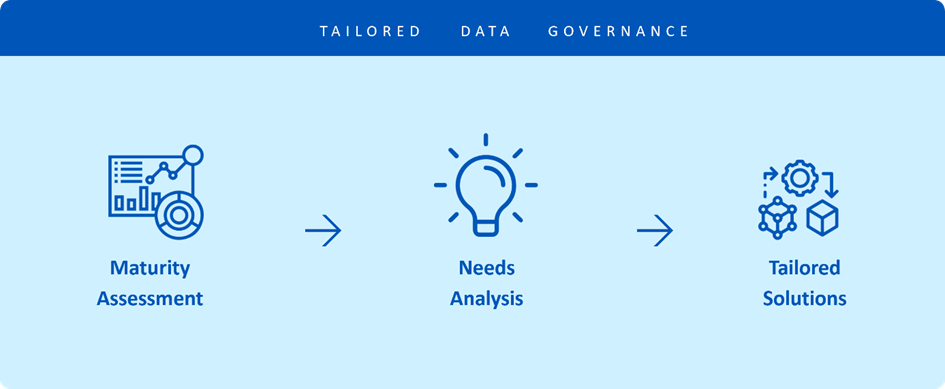Data Governance – what exactly are we talking about?

Awareness of the value of data collected by companies is growing every year. A welcome side effect of that trend is that more attention is being paid to Data Governance processes. Unfortunately, many times organizations are experiencing difficulties when implementing Data Governance. One of the reasons for that are the misunderstandings that often arise in this area. Some of these stem from the fact that multiple definitions of that term exist. If that’s the case – let’s see if we can find some common ground in those.
Data Governance – definition
Here’s some reasonable definitions of the term “Data Governance”:
- “The exercise of authority and control (planning, monitoring, and enforcement) over the management of data assets.” (DAMA International)
- “A system of decision rights and accountabilities for information-related processes, executed according to agreed-upon models which describe who can take what actions with what information, and when, under what circumstances, using what methods.” (Data Governance Institute)
- “The specification of decision rights and accountability framework to ensure the appropriate behaviour in the valuation, creation, consumption, and control of data and analytics.” (Gartner Glossary)
Some common elements can be identified in attempts to define Data Governance:
- development of processes, policies, and standards that outline how data is to be managed during its complete lifecycle (creation, storage, usage, archiving, deletion) – PROCESS
- establishment of roles and responsibilities for data management – PEOPLE
- assurance of data availability, quality, integrity, and security – TECHNOLOGY
These three aspects are the key to how we approach Data Governance here at BlueSoft.
Data Governance combine peoples, processes, and technology. All those aspects are essential to successful Data Governance implementation.

Among areas defined around DG and its pillars we can mention:
- Knowledge – Gathering, improving and sharing knowledge about data, making data more lucid and easy to interpret.
- Ownership – Determining accountability for managing data to ensure that the right people define usage and quality standards, and consistently resolve data issues
- Availability – Ensuring that data is available and easy to consume by the business teams that need it
- Security – Classification and protection of data according to the adopted policies
- Quality – Implementation of data quality standards and procedures including monitoring and recording rules
Data Governance is not the same as Data Management
One of the reasons why wrong goals are set in Data Governance programs is the lack of clear understanding of the difference between Data Governance and Data Management. Having said that – how can we understand this difference?
In short, Data Governance is part of the overall Data Management discipline. Data Management is the overarching framework in which Data Governance procedures and policies are implemented and executed. Data Governance focuses on strategy and planning, meanwhile Data Management focuses more on technology and tools.
Data Governance Goals
Although the implementation of Data Governance can be different in every organization, there are some universal goals for Data Governance programs:
- Provide knowledge and confidence in data, which in turns allows to make optimal business decisions
- Establish an environment for the development of Business Intelligence reporting as well as Data Science initiatives
- Support a data-driven culture of work
- Optimize efficiency by not having to repeatedly clean and prepare the same data
- Increase Data Monetisation capabilities
- Improve data security and compliance with regulations
Data Governance Benefits
Some common business benefits associated with implementation of Data Governance:
- Standardization of data definitions across an organization
- More accurate analytics
- Efficient, effective and reliable business reporting
- Increased value of data held
- Established data management roles and responsibilities and data use policies
- More effective knowledge sharing across the organization
- Strengthen of data democratization
- Transparent data ownership structure
- Ability to analyse data lineage and conduct impact analysis
The BlueSoft Tailored Data Governance approach
Statistics and experience show that many Data Governance programs fail. Obviously one of the reasons for that are misunderstandings over definition and goals of Data Governance. However, there is another reason – organizations often adopt implementation approach mismatched to their needs and capabilities. Generally, large initiatives are launched that are too difficult to implement across the organization. This is usually due to inadequate guidance and a lack of experience in launching and running such initiatives.
BlueSoft’s answer to this problem is a bottom-up approach to data-driven transformation called “Tailored Data Governance”. It is a practical approach to the familiar but also the general statement “Think Big, Start Small”. It involves assessing organization’s data-driven maturity and the current state of Data Governance, analysing client’s needs and challenges, and developing a solution that addresses them as simply as possible. Such an approach makes the implementation of Data Governance easier and the benefits more tangible.

What Can We Do For Your Business?




